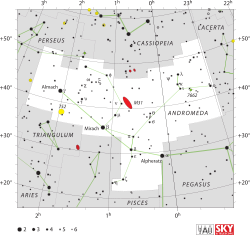Theta Andromedae
Theta Andromedae (Theta And, θ Andromedae, θ And), som är stjärnans Bayerbeteckning, är en dubbelstjärna i mitten av stjärnbilden Andromeda. Den har en genomsnittlig skenbar magnitud på omkring +4,6 [2] och är synlig för blotta ögat från områden utanför stadsregioner och utan ljusföroreningar. Baserat på parallaxmätningar befinner den sig på ett avstånd av ca 310 ljusår (95 parsek) från solen.[1]
| Theta Andromedae (θ) | |
 | |
| Observationsdata Epok: J2000.0 | |
|---|---|
| Stjärnbild | Andromeda |
| Rektascension | 00t 17m 05,49885s[1] |
| Deklination | 38° 40′ 53,8902″[1] |
| Skenbar magnitud () | 4,61[2] |
| Stjärntyp | |
| Spektraltyp | A2 V[3] |
| U–B | +0,05[2] |
| B–V | +0,06[2] |
| Astrometri | |
| Radialhastighet () | 0,9[4] km/s |
| Egenrörelse (µ) | RA: -49,35[1] mas/år Dek.: -17,65[1] mas/år |
| Parallax () | 10,56 ± 0,96[1]mas |
| Avstånd | 310 ± 30 lå (95 ± 9 pc) |
| Detaljer | |
| Temperatur | 8 960 [5] K |
| Metallicitet | +0,14[5] |
| Vinkelhastighet | 102[6] |
| Andra beteckningar | |
| 24 Andromedae, BD + 37 ° 34, HD 1280, HIP 1366, HR 63, SAO 53777. | |
Egenskaper
redigeraTheta Andromedae är en vit dvärgstjärna i huvudserien av spektraltyp A. Den ser ut vara en dubbelstjärna med en massiv, omkretsande förjeslagare, möjligen av typ A, på ett avstånd av cirka 1 astronomisk enhet.[7] En ljussvagare följeslagare är separerad från Theta Andromedae med 0,06 bågsekunder.[8]
Källor
redigera- Den här artikeln är helt eller delvis baserad på material från engelskspråkiga Wikipedia, tidigare version.
Referenser
redigera- ^ [a b c d e f] van Leeuwen, F. (November 2007), "Validation of the new Hipparcos reduction", Astronomy and Astrophysics, 474 (2): 653–664, arXiv:0708.1752 Freely accessible, Bibcode:2007A&A...474..653V, doi:10.1051/0004-6361:20078357
- ^ [a b c d] Johnson, H. L.; et al. (1966). "UBVRIJKL photometry of the bright stars". Communications of the Lunar and Planetary Laboratory. 4 (99). Bibcode:1966CoLPL...4...99J.
- ^ Cowley, A.; et al. (April 1969), "A study of the bright A stars. I. A catalogue of spectral classifications", Astronomical Journal, 74: 375–406, Bibcode:1969AJ.....74..375C, doi:10.1086/110819
- ^ Evans, D. S. (June 20–24, 1966), "The Revision of the General Catalogue of Radial Velocities", in Batten, Alan Henry; Heard, John Frederick, Determination of Radial Velocities and their Applications, Proceedings from IAU Symposium no. 30, University of Toronto: International Astronomical Union, Bibcode:1967IAUS...30...57E
- ^ [a b] Hill, G. M. (February 1995), "Compositional differences among the A-type stars. 2: Spectrum synthesis up to V sin i = 110 km/s", Astronomy and Astrophysics, 294 (2): 536–546, Bibcode:1995A&A...294..536H
- ^ Royer, F.; Zorec, J.; Gómez, A. E. (February 2007), "Rotational velocities of A-type stars. III. Velocity distributions", Astronomy and Astrophysics, 463 (2): 671–682, arXiv:astro-ph/0610785 Freely accessible, Bibcode:2007A&A...463..671R, doi:10.1051/0004-6361:20065224
- ^ Goldin, A.; Makarov, V. V. (September 2006), "Unconstrained Astrometric Orbits for Hipparcos Stars with Stochastic Solutions", The Astrophysical Journal Supplement Series, 166 (1): 341–350, arXiv:astro-ph/0606293 Freely accessible, Bibcode:2006ApJS..166..341G, doi:10.1086/505939
- ^ Eggleton, P. P.; Tokovinin, A. A. (September 2008). "A catalogue of multiplicity among bright stellar systems". Monthly Notices of the Royal Astronomical Society. 389 (2): 869–879. arXiv:0806.2878 Freely accessible. Bibcode:2008MNRAS.389..869E. doi:10.1111/j.1365-2966.2008.13596.x.


